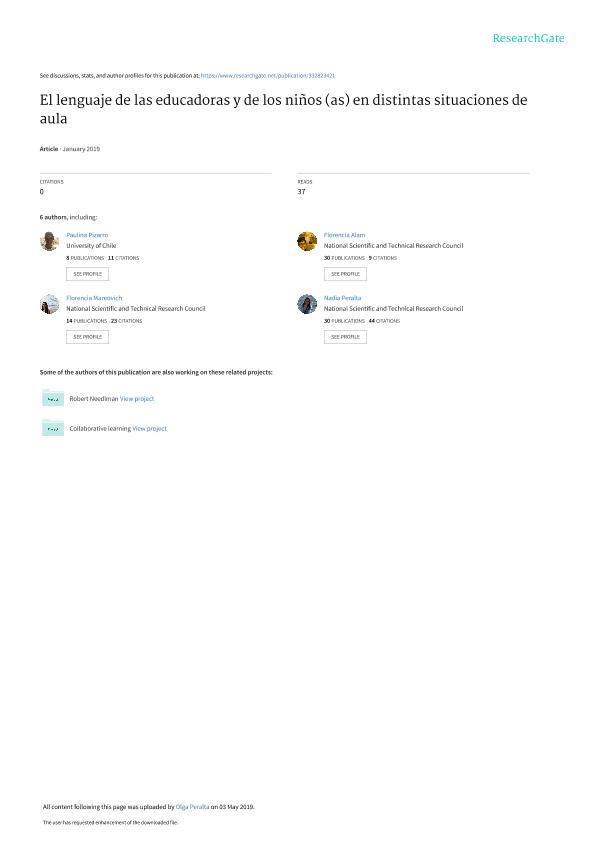Artículo
Esta investigación explora si ciertas propiedades como la cantidad, la complejidad sintáctica y la diversidad léxica del habla de maestras(os) y niños(as), configuran patrones de lenguaje diferenciados según distintas situaciones de aula de educación inicial. Para ello, se analizaron 47 situaciones de interacción entre alumnos(as) de nivel socioeconómico medio bajo y bajo y sus maestras en salas de establecimientos educativos públicos de la Provincia de Entre Ríos, Argentina. Se realizó un análisis multivariado que reúne técnicas de análisis factorial y de clasificación. Los resultados permitieron agrupar las situaciones en tres clases: compuesta mayormente por situaciones de lectura de cuentos, con turnos largos por parte de la maestra y mayor complejidad sintáctica en los(as) alumnos(as); compuesta por situaciones de juego de rincón, donde tanto la maestra como los(as) niños(as) desplegaron un mayor volumen de habla; y situaciones de ronda, en las que se identifica un volumen de habla menor que en las otras dos clases. Con excepción de la diversidad léxica, las propiedades lingüísticas consideradas contribuyeron a dar cuenta de las configuraciones particulares que asumen los intercambios en las situaciones de lectura de cuentos, ronda y juego de rincón. Se discuten los resultados a la luz de la literatura y de sus implicancias educativas. This research explores certain properties, like the quantity, syntactic complexity and lexical diversity of the speech of teachers and children in different classrooms situations in early childhood education. Specifically, it analyzes whether those properties configure differentiated language patterns according to the ongoing classroom activity. Forty seven interactions between medium-low and low socioeconomic status children and their teachers in public educational institutions of the Province of Entre Ríos, Argentina, were analyzed. A multivariate analysis that gathers techniques of factor analysis and classification was carried out. The results configured three classes: composed mostly of story-reading situations, with long turns by the teacher and syntactic complexity in the children; composed of corner play situations, where both the teacher and the children displayed a greater volume of speech; and constituted mainly by round situations, with an overall lower speech volume than the other two classes. With the exception of lexical diversity, the linguistic properties considered contributed to explain the particular configurations of the interchanges in the story reading, corner play and round situations. The results are discussed in light of the literature and the educational implications.
El lenguaje de las educadoras y de los (as) niños (as) en distintas situaciones de aula
Título:
The language of educators and preschool children in different classroom situations
Pizarro, Paulina; Peralta, Nadia Soledad ; Audisio, Cynthia Pamela
; Audisio, Cynthia Pamela ; Mareovich, Florencia
; Mareovich, Florencia ; Alam, Florencia
; Alam, Florencia ; Peralta, Olga Alicia
; Peralta, Olga Alicia ; Rosemberg, Celia Renata
; Rosemberg, Celia Renata
 ; Audisio, Cynthia Pamela
; Audisio, Cynthia Pamela ; Mareovich, Florencia
; Mareovich, Florencia ; Alam, Florencia
; Alam, Florencia ; Peralta, Olga Alicia
; Peralta, Olga Alicia ; Rosemberg, Celia Renata
; Rosemberg, Celia Renata
Fecha de publicación:
04/2019
Editorial:
Pontificia Universidad Católica de Chile
Revista:
Pensamiento Educativo
ISSN:
0719-0409
Idioma:
Español
Tipo de recurso:
Artículo publicado
Clasificación temática:
Resumen
Archivos asociados
Licencia
Identificadores
Colecciones
Articulos(CIIPME)
Articulos de CENTRO INTER. DE INV. EN PSICOLOGIA MATEMATICA Y EXP. "DR. HORACIO J.A RIMOLDI"
Articulos de CENTRO INTER. DE INV. EN PSICOLOGIA MATEMATICA Y EXP. "DR. HORACIO J.A RIMOLDI"
Articulos(IRICE)
Articulos de INST.ROSARIO DE INVEST.EN CS.DE LA EDUC. (I)
Articulos de INST.ROSARIO DE INVEST.EN CS.DE LA EDUC. (I)
Citación
Pizarro, Paulina; Peralta, Nadia Soledad; Audisio, Cynthia Pamela; Mareovich, Florencia; Alam, Florencia; et al.; El lenguaje de las educadoras y de los (as) niños (as) en distintas situaciones de aula; Pontificia Universidad Católica de Chile; Pensamiento Educativo; 56; 1; 4-2019; 1-18
Compartir
Altmétricas



